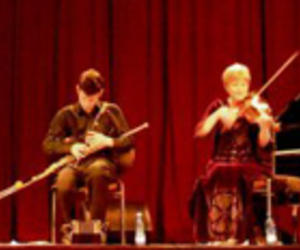The greening of Havana
- Submitted by: manso
- Editorial Articles
- 03 / 21 / 2011

An Irish cultural week helped forged even stronger connections in the Cuban capital, Havana, this month PERHAPS IT was just the heat, but, as Iarla Ó Lionáird lifted his voice into the rafters of Havana’s venerable Basilica Menor de San Francisco de Asis, we felt a shiver run down our spines. To hear Ó Lionáird’s sean nós fill the vast, dim space above our heads, here in the heart of Habana vieja (Old Havana) where music is so vital, was to feel a momentary swell of tír grá. And the standing ovation it received from an attentive Cuban audience confirmed that Ó Lionáird’s nuanced laments touched an emotional chord even for those not raised on its sound.
The concert, which also featured a performance of traditional and original music from pianist Mícheál Ó Súilleabháin, was the opening night of Havana’s Journados Culturales con Irlanda , a week of Irish culture which brought a touch of green to the Cuban capital earlier this month.
Organised by the Irish Embassy in Mexico, which is also accredited to Cuba, the week saw Irish music, dance, films and literature warmly received in some of Havana’s most prestigious venues and went a long way to strengthening the bonds that connect Ireland and Cuba.
“Ireland and Cuba have much in common,” says Eamon Hickey, Ireland’s ambassador to Cuba, in his speech in Spanish which opened the week. “A colonial history that has left in its wake a fascinating cultural mix; the language of a conqueror which we have molded to define our own identity; we are both islands with a large neighbour – for better or for worse – and we share a long tradition of emigration.”
The ambassador also made reference to the Irish connection, best known to Cubans when he quoted Ernesto Che Guevara Snr, father of Cuba’s iconic hero: “Through my son’s veins runs the blood of Irish rebels”. But there are many others, and among the Irish contingent in Havana for the week were Professor Jim Deegan of the University of Limerick, who is advising the Cuban authorities on tourism, and businessman Alfie Byrne, who is planning to open an Irish bar and cultural centre in old Havana. Later, walking down O’Reilly street – named for General Count Alejandro O’Reilly, a native of Co Meath, who organised the defences of Havana in 1763 – and hearing Ó Lionáird and Ó Súilleabháin chatting away in Irish, it seemed as if Havana was turning greener by the minute.
In contrast to the depth and sincerity of the opening concert, the performance by members of Comhaltas Ceoltóirí Éireann at the National Theatre of Cuba later in the week struck some Irish observers as belonging to an earlier, more self-conscious expression of the Irish tradition.
With flowing gowns and impish charm, and a role call of Irish standards including An Poc Ar Buile , this was not a concert for the cognoscenti. But for the open-minded Cuban audience, it was a spirited introduction to the Irish vernacular tradition, and the Irish dancing of Argentinean Fernando Marcos brought the generous audience to their feet.
In his opening speech, Hickey also praised the Irish NGO Una Corda, which works with the Cuban authorities to repair broken pianos in the music schools of Havana. The project receives funding from the Irish Government, and those funds are helping to restore the historic National Workshop of Instrument Repair in central Havana where Una Corda has its headquarters. A cavernous old warehouse, built before the revolution to service a booming entertainment industry, the Una Corda workshop was the setting for one of the week’s most unusual and most joyous events.
Some of Havana’s best young pianists, who practise on pianos fixed with materials brought by Irish visitors to Cuba, performed pieces by Irish composers, including Turlough Ó Carolan and John Field. The warmth of their reception was not just because all the performers’ parents were present. It was also testament to the good will and great friendships that this Irish project is fostering in the Cuban music community.
The week also featured a season of Irish films at the Cinemateca de Cuba – including screenings of Niall McKay’s The Bass Player and Cathal Black’s Korea – and a roundtable discussion on Irish literature at the University of Havana.
Mindful of circumstances back home, embassy officials were at pains to point out that the Irish Cultural Week was run on a shoestring, with all the performers waiving their fees, but there was a sense that it is hard to put a price on this kind of cultural diplomacy.
Source: www.irishtimes.com/newspaper/features/2011/0321/1224292705596.html
Comments